July 23rd saw new announced trailers, mostly video based, on upcoming X-Box games, intended for release in 2020 or 2021. Heading them all up was the latest in the first-person shooter, sci fi video games series, Halo – one I am myself an aficionado, of – now moving to next generation tech, in part, on the X-Box One Series X, the revamped version. It was also the only one to really show extensive gameplay, in detail, plus a brief interview with Studio head Chris Lee, afterward.
 As the flagship series for much of the original X-Box, Halo as a series has already travelled a long road, and a fairly rocky one, over the last nineteen years. Debuting in 2001, with Halo: Combat Evolved, with a solid multiplayer and jam packed campaign, the series further developed with 2005’s Halo 2, which revolutionised X-Box multiplayer, coupled with a longer campaign, and more developed story. All was stewarded by Bungie Corporation, operating under Microsoft, who continued the series onto the newer X-Box 360 console with Halo 3, in 2007, and then into further spin off games. But with Bungie having completed their five games contract with Microsoft, by 2010, the stage was set for them to depart to make a new franchise. Several key members of Bungie departed the host company, including Josh Holmes, and Frank O’Conner, to form the new 343 Industries corporation, named after a prominent Halo character. They partnered with Bonnie Ross as overall studio head, before developing a new direction for the game series, beginning first with an updated, Anniversary addition of the original Halo game (Halo: CE Anniversary) with revamped graphics, music, and an option to switch back to the old ones for both; and then continued into 2012 with their release of Halo 4, part of the planned ‘Reclaimer Saga’ which now seems more open ended than a trilogy.
As the flagship series for much of the original X-Box, Halo as a series has already travelled a long road, and a fairly rocky one, over the last nineteen years. Debuting in 2001, with Halo: Combat Evolved, with a solid multiplayer and jam packed campaign, the series further developed with 2005’s Halo 2, which revolutionised X-Box multiplayer, coupled with a longer campaign, and more developed story. All was stewarded by Bungie Corporation, operating under Microsoft, who continued the series onto the newer X-Box 360 console with Halo 3, in 2007, and then into further spin off games. But with Bungie having completed their five games contract with Microsoft, by 2010, the stage was set for them to depart to make a new franchise. Several key members of Bungie departed the host company, including Josh Holmes, and Frank O’Conner, to form the new 343 Industries corporation, named after a prominent Halo character. They partnered with Bonnie Ross as overall studio head, before developing a new direction for the game series, beginning first with an updated, Anniversary addition of the original Halo game (Halo: CE Anniversary) with revamped graphics, music, and an option to switch back to the old ones for both; and then continued into 2012 with their release of Halo 4, part of the planned ‘Reclaimer Saga’ which now seems more open ended than a trilogy.
Halo 4 was highly received, for the most part, but with some complaints on changes to the multiplayer, art style and some of the mechanics. The story of the main campaign was considered the high point, though with some critical feedback on perceived changes to the main protagonist – the iconic Master Chief (aka John 117). This concerned both characterization and character design – in particular, the aesthetic changes to his iconic power armour (which I did not really mind that much) and his golden hued visor (which I did somewhat have issues with changing, texture-wise). The main storyline also leaned a little too heavily on if one chose to watch the unlockable Terminals in game, which could only be viewed on the Halo Waypoint website – in order to learn more of the backstory of the game’s new villains, the Promethean Knights, and their master; whilst the reappearance of a faction of Covenant as earlier adversaries in the gameplay was left mainly to spin-off novels. The actual campaign was pretty satisfying overall, though, except for some of the enemy encounters – which, with the Knights, on higher difficulties, could become somewhat unforgiving and repetitive. Balancing that out was new vehicles, like the fan-pleasing Mantis, a stomp-tastic mecha fighting bipod, plus a flying sequence to open up the last level; and new weapons, plus the return of jet packs, and the new thruster pack, which changed up multiplayer encounters, as well. Significantly more mixed feedback on the design of the multiplayer and it’s leveling up system was another worrying reaction to the game for the studio – though quite a few new fans were drawn in.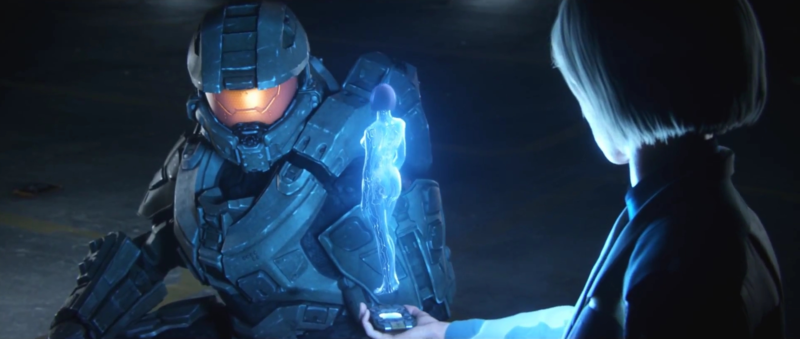
The plot saw Master Chief struggle to save his holographic friend/soul mate Cortana from a progressively more inevitable decay, as her cognitive processes begin to overwhelm her own personality, implying looming brain death – whilst the imposing Didact, exiled war hero of the ancient Forerunners, is inadvertently awoken, and unleashes his Knights to oppose what he sees as an unearned human ascension. Much of his personal motivation remained only briefly told though, and confined to the unlockable in-game Terminals, and disconcertingly, a Greg Bear written novel released only after the game had already premiered, which filled in a few further details. Still, Keith Szarabajka delivered a very impressive performance, in his distinctive voice, reminiscent of his role in the Mass Effect games trilogy. Actress Lori Tritel also popped up as a simulacra of the mysterious Librarian, who represented the polar opposite view of the Didact, both concerning the philosophy of the Mantle, and who was fit to hold it, in having guardianship over other species, and what that meant. All was still helpfully boiled down to the central theme of whether the Master Chief was more than a machine-like soldier trapped in armour and unthinking obedience, as epitomized by both the Didact and his Knights (souls literally trapped in machines) and capped off by Cortana’s moving sacrifice to protect him, and save Earth one more time.
Three years passed until the sequel, Halo 5 Guardians, marked by further novels, and the Escalation comic series – which, in a worrying move, brought back the Didact (heavily hinted to have survived Halo 4 before) only to literally shelve him by having him become trapped within his own weapon, the Composer (or some fairly hackneyed blowback effect of it being wrecked, at least) with only assurances from writers Brian Reed and Frank O’Conner that he is still being saved for a later surprise, and was not pertinent to the direction of the new story, yet. Added to that was a hasty three issue treatment of the tale, which had to also squeeze in a reunion with the Chief’s old comrades, Blue Team, from prior novels, and longtime fans were beginning to become a bit concerned. Still, Halo 5 forged ahead with an impressive marketing campaign, featuring video trailers, viral marketing, a decent if somewhat clunky live action mini movie entitled Nightfall – starring Mike Colter from the Luke Cage tv show – and most creatively, a full fledged audio drama entitled Hunt the Truth, starring comedian Keegan-Michael Key as a journalist uncovering the true, covered up origins of the Master Chief; being shocked by his alleged betrayal of a diplomat, and then harried by the menacing Office of Naval Intelligence – all hinting at some kind of major face off between the Chief and his former superiors, whilst unrest and chaos formented among human planets. Gameplay reveals showed a cooperative-focused campaign with up to four players involved (though no split-screen, as was previously used in cooperative games – typically a minor revamp of campaigns to allow dual linked controllers) and anticipation built once more.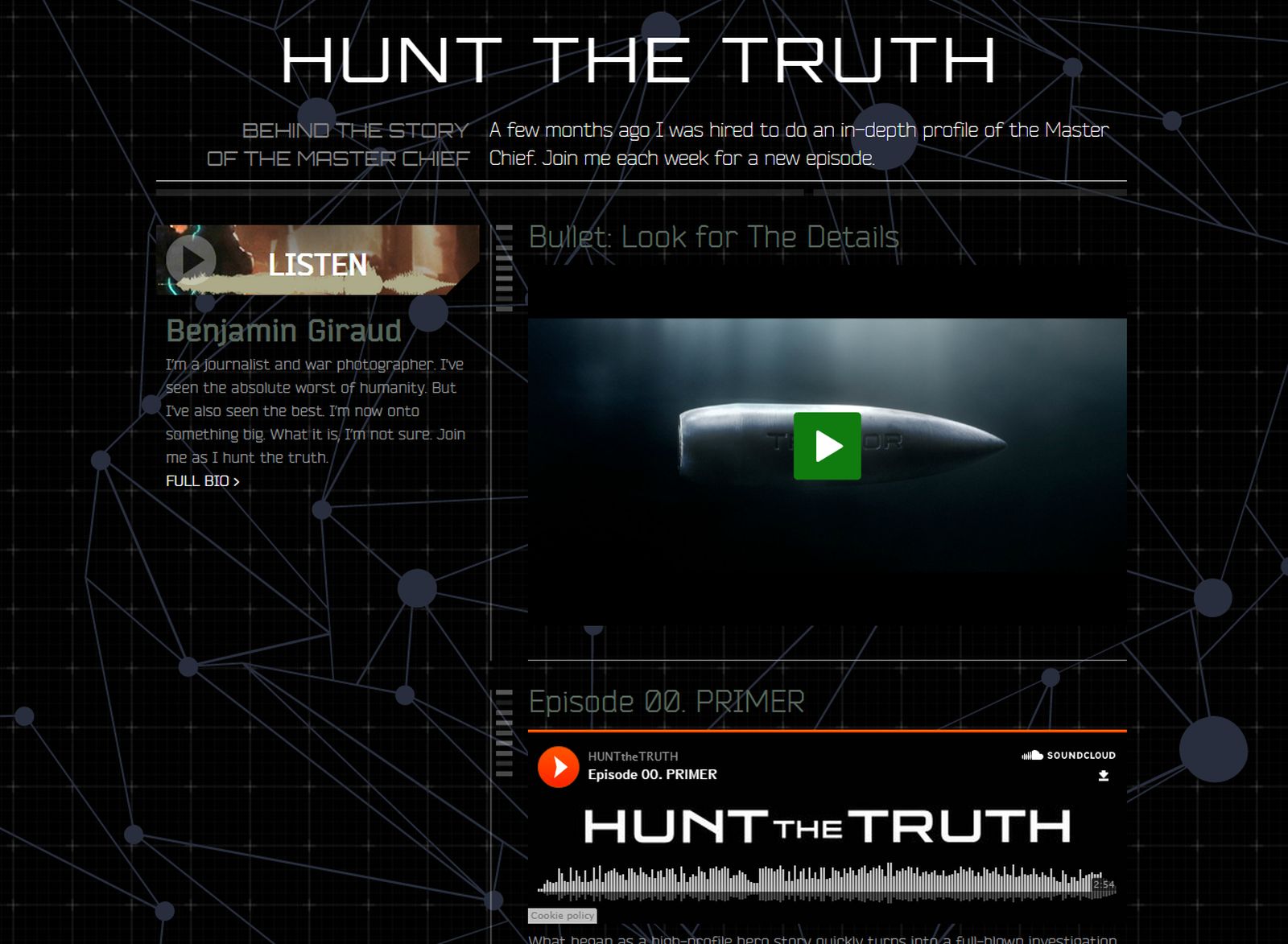
When the game finally released, in October 27th 2015, audience reactions was alarmingly mixed, perhaps more so than the previous game. Gameplay remained solid, but also significantly altered from prior games, with more concessions to players of other franchises, such as Call of Duty, with a semi ‘aim-down-sights’ mechanic, way more mobility involving clambering mechanics and ground-pound/slamming into enemies, and more. But whilst much of this paid off to fairly good success in multiplayer, the single player campaign – mainly written by Brian Reed, who had done the narrative for Halo 4’s DLC ‘Spartan Ops’ missions – came in for a significant mauling. The plot had boiled down to a very simple process of ‘hunt the Master Chief and his team’ whilst playing a new character – Spartan Locke – for twelve out of fifteen total missions, and the much advertised face-off between the two Spartans was concluded in an anticlimatic cutscene less than halfway into the story. Almost nothing of the Hunt the Truth audio drama or the recent comics had much impact on the narrative, which concluded with the heavily telegraphed return of Cortana, seemingly corrupted and obsessed with a new goal of seizing the Mantle – and indeed, the galaxy – for herself and artificial intelligences like her: thus abruptly derailing many of the expected story directions fans had been anticipating – and with bare lip service paid to her unlikely resurrection. A mystery of sorts still remained, and some of the dialogue still managed to hold up the flagging story, but it was an insubstantial follow up to salve years of expectation, and the larger gap to follow before the next game.
It also felt like a massive change of direction spurred by selective fan feedback from the last game, but with little substantial to replace what had been set up previously. The big twist about Cortana being untrustworthy was pretty obvious from the fifth level onward, and little actual development was done with the Master Chief, except to confirm his loyalty to humanity over Cortana for now, leaving Ike Amadi as Spartan Locke to carry much of the dialogue scenes, if ably supported by returning actors Nathan Fillion (of the cult tv show Firefly) as Spartan Buck, and Keith David, as the legendary Arbiter of Halo 2 fame, his deep, honeyed timbre voice as resplendent as ever. Jen Taylor meanwhile played both Cortana once more, and her enigmatic creator Doctor Halsey, who has some okay scenes (though not a patch on her scene-stealing turn in Spartan Ops) and Steve Downes remained laconic as ever as Chief.
Helping to save the game from further infamy was some solid arena style multiplayer matches, serviceable co-op gameplay, and the new Warzone mechanic – a free-for all multiplayer battleground involving AI enemies mixed with competing teams of other players, gaining points to unlock vehicles, weapons, buffs and other advantages, on fairly expansive level maps. Further post launch content and a plethora of custom, unique and unlockable weapons further salved fan concerns, but the story remained fairly moribund. Hope for future narrative quality received a buff with a release of Halo Wars 2, the sequel to the 2009 strategy game, with impressive graphics and even more impressive CGI cutscenes animated by Blur Studios, enlivening a decent narrative of an outgunned human ship battling new enemies the Banished, whilst cut off far from human space, above the majestic Forerunner Ark – a huge, sprawling habitat in deep space, with patchworks of varying terrain. Dominating the advertising was new villain Atriox, as the face of the Banished, a marauding bunch of ape-like brigands, akin to Halo 3’s Brute hordes. Meanwhile, 343 studios progressed with ambitious plans to develop an entire new game engine for the X-Box One S and other iterations, with rumours of semi-open world gameplay flying thick and fast.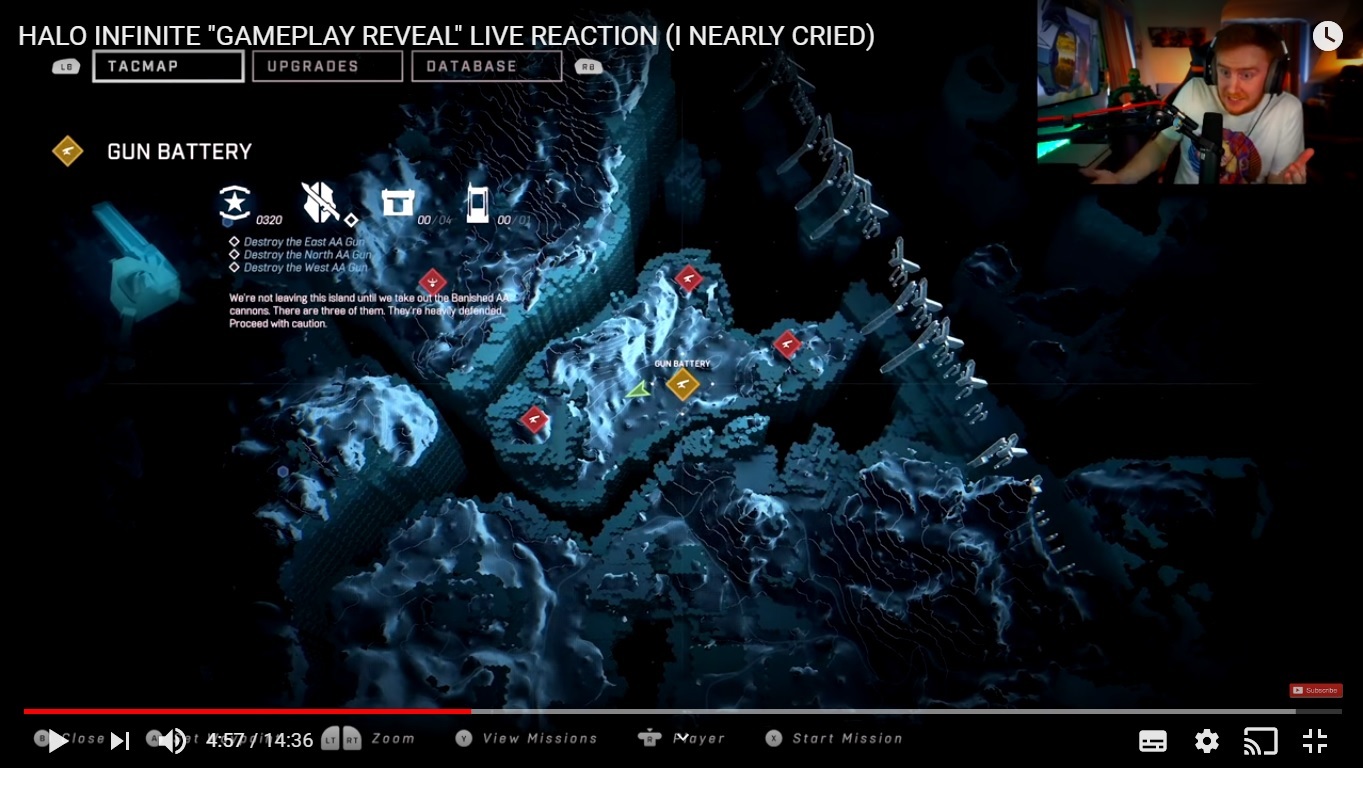
The new Halo Infinite trailer and gameplay video has largely confirmed these rumours, depicting the return of the Master Chief (John 117) crash landing on a damaged Halo ring, aided by a flighty, nervous pilot, voiced by Nicholas Roye, in an as yet un-named role. Set over a year and a half after Halo 5, the laconic Master Chief – still played by Steve Downs – confronts the vicious Banished, who have driven humanity off of Zeta Halo, the oldest and most mysterious of the eponymous Halo ring habitats, that drove the plot of the original three games – and it’s implied humanity is in it’s most precarious position in years, beset by enemies on multiple sides. Exploration is a big theme of the demo, as a detailed map shows wide open areas – initially segmented into walled wedges, with various cliffs, rivers, chasms and inclines serving to slow players down to begin with – but compensated for by a new grappling hook attached to the player’s left arm, allowing one to rapidly take short cuts over low cliffs and obstacles, draw objects toward you, or rapidly close to a enemy for a quick take down. Further objectives are hinted at on the in-game map, beginning with disabling anti aircraft turrets, and further objectives implied, such as camps, enemy leaders and challenges, according to further studio feedback. The comparisons that are most apt seem to be with games like Shadow of Mordor, the expansive Lord of the Rings inspired game, where players roamed over a wide playspace and challenged or assassinated various warlords, Orcs and other opponents, in pursuit of their future goal. The impressive opening cutscene is also filmed according to the style of God of War 4, in a continuous sweeping take with either no, or as few cuts, as possible.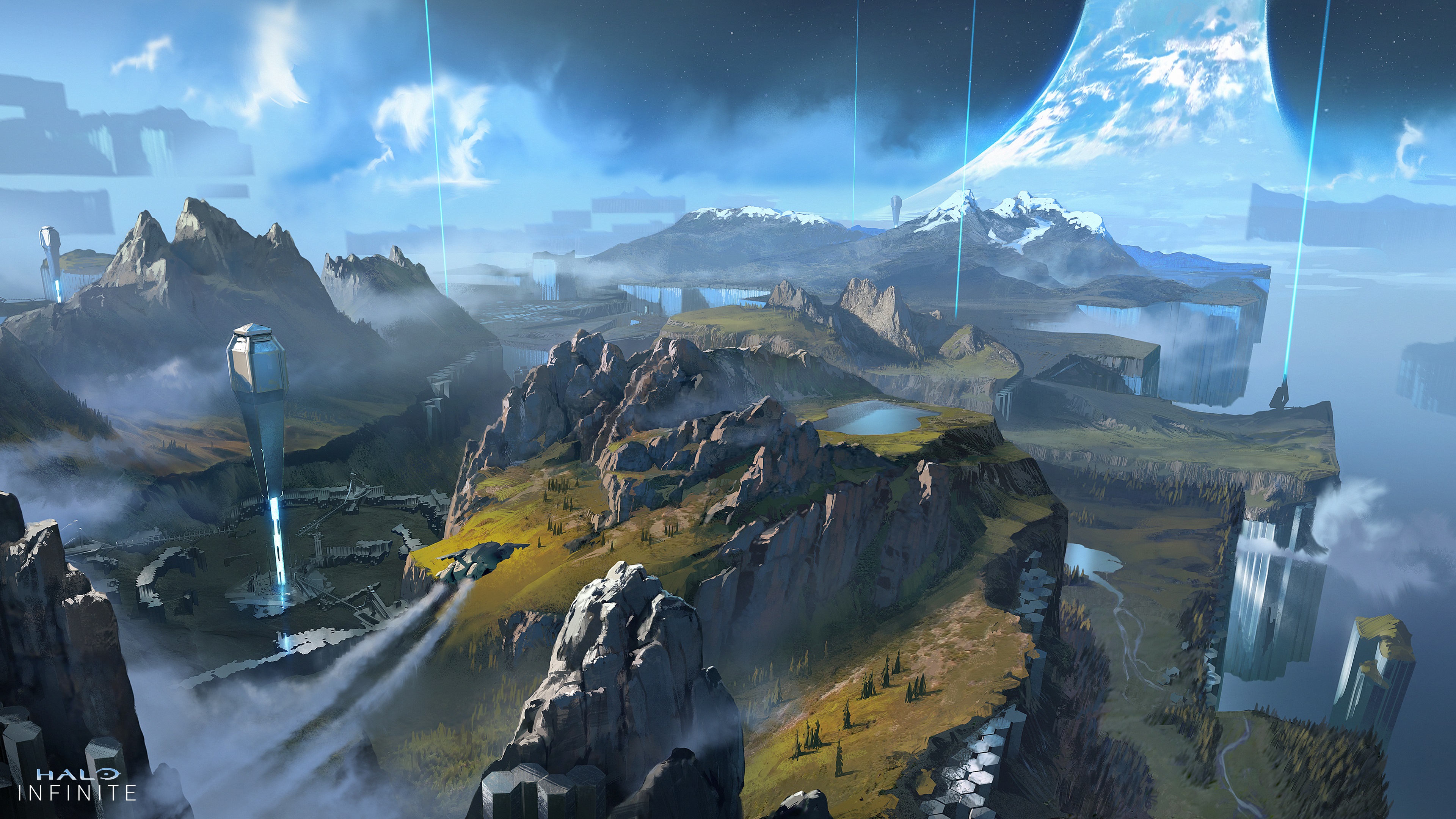
Vocally, Downs is on point, and his character seems to be decently bouncing off of the Pilot, as voiced by Roye, who is promised to be one of the more relatable sidekicks the franchise has yet had, traumatized by recent defeats he was caught in the middle of, yet still fighting hard to go home. Unfortunately, in ironic action movie fashion, he is stuck alongside a protagonist who typically walks straight into danger, shrugging off bullets and peril as he goes, making for a potentially fun dynamic – with hopefully more complexity to come. We can also hope to see further development on Chief’s character, as Halo 4 set up. And last year’s reveal trailer, showcasing beautiful landscapes (which may, or may not be all explorable) also revealed Cortana was not forgotten either, as she will be making some appearance, later in the storyline. A further unlockable secret audio file also implies some sort of split identity at work, with a lost part of Cortana somewhere lurking in the wings. The gameplay trailer, totalling some five minutes of gameplay, leads into another filmic cutscene introducing new villain Escharum, voiced by Darin de Paul – an aging Brute warrior (Jiralhanae, as his own people refer to themselves) looking to honour the name of the Banished, and seeking a final worthy battle to test himself in, against humanity’s most celebrated soldier. This does not prevent him from boasting about the ease with which he defeated the humans already opposed to him, and referring to the Chief leadingly as ‘prey’. Emphasising this is a story that will live on in legends, he urges Chief (and the player) to ‘bare your fangs! Fight hard – die well’ – and setting up a personal conflict to go along with the wider story stakes. Though perhaps a little on the nose, in delivery, this emphasises the function of the Banished as a enemy with personality, who one can pit oneself against in entertaining fashion – as opposed to the more impersonal, if initially creative Prometheans, of the last two games.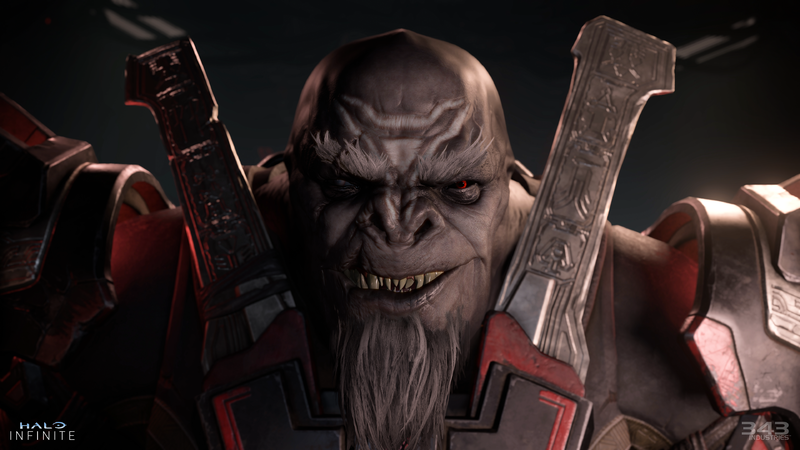
But as with much Halo content, there was a mixed blessing element to all of this, as fan reactions to the graphics of (and admittedly already months old trailer, held back by Covid 19 delays to the schedule, and other testing issues) did not altogether overwhelm, exhibiting visible pop up, draw/fade issues and graphical uncertainties, coupled to a fairly cartoonish art style, at times. Bright armour colours and unexpectedly simple architecture – including almost Lego-like spires of basalt like rock, dotting the sides of the valley environment – all contributed to a very mixed visual tone, although textures remain impressive. It’s perhaps a very purposeful return to the colourful style of the original three games, in vivid environments, when compared to the particle effects, lighting and metallic stylings and ambience of Halo 4 and 5, yet still somewhat jarring – further epitomised by a Banished dropship, taken straight out of Halo Wars 2, that retains the blocky design features from the model used in that strategy based game. Some were heavily turned off by this approach, which may have contributed towards the recent announcement from Microsoft and 343 of delaying the game several months (if not longer) into some time in 2021. In other surprising news, on August 26th, Joseph Staten, former co-writer of the original three Halo games, was announced as joining the team behind Halo Infinite as ‘campaign lead’ in order to polish up and steward various campaign development issues (although with the campaign presumably mostly done, it’s unclear what the full scope of his role will be) It is also likely he will be working extensively on post launch content, as Microsoft has announced Halo Infinite is now the franchise umbrella title for potentially ten years going forward, with much extra content and expansions intended after. This likely includes new campaign missions, additional story, and more cutscenes – as was the case with Halo Wars 2’s expansion, Awakening the Nightmare, which had more blur cutscenes and a short campaign focused on the Banished as protagonists.
As one of the original script writers from the storyline up to Halo 3, and working off of the old Halo story Bible devised by Eric Trautman, Brannon Boren, and Robert McLees, Staten had a somewhat different take on the backstory to the enigmatic Forerunners, from Halo’s deeper lore, than Frank O’Conner and other writers – O’Conner having come in during Halo 3’s development, and begun to take things in a somewhat different direction, first hinted at in Halo 3’s text Terminals, viewable within the later levels of that game. This continued a tradition since Bungie’s earlier games like Marathon, in the 1990s, of having additional discoverable story content. This tradition is also set to continue in Halo Infinite, with the promise of much discoverable lore in locations around the Halo ring, and probably an in-game Codex, as well. Joseph Staten had contributed to such material previously during his time away from Halo, working with Activision’s franchise Destiny, which was designed by many of his old Bungie coworkers.
Lurking in the background all that time had been a hinted at deeper narrative about the nature of the cosmos, and artificial minds like Cortana, tied up in the tragic backstory of the Forerunners, their fall from early nobility into later hubris, and their downfall at the hands of the horrific parasite swarm known as the Flood, guided by a nightmarish entity called a Gravemind, that later 343 lore revealed had sworn revenge on the Forerunners on behalf of their own long vanished ‘gods’ ; in a sinister echo of the religious beliefs the original enemies (the Covenant) of the Master Chief, had viewed the Forerunners by. Much of that lore fittingly converged to a narrative head on Zeta Halo, the very Halo ring on which this newest game in the franchise is to be set, so some chickens may soon be coming home to roost, come 2021. This is after an admittedly rather protracted period of wheelspinning since Halo 4 came out, with even the novels often skirting around the wider implications, or dropping only nuggets of new information each time. Part of this had involved somewhat unwieldy retcons of the backstory of the Didact leading up to Halo 4, to set him up as an enemy rather than an ally, as Halo 3’s terminals had once implied, which caused a fair degree of convolution in the backstory – though still adding to the more tragic themes of hubris and sacrifice. Halo Infinite is also the best chance players have had so far to encounter the infamous backstory character of Mendicant Bias – a close counterpart, of sorts, to Cortana, in some ways – and his shocking betrayal of his Forerunner creators, with him last implied to be seeking atonement from humanity, and any of his creators who perhaps survived. Whilst we may not encounter him within the narrative of the game itself, it’s quite likely we will learn some new things about him, via videos or text or audio files, and his chilling alliance with the Flood – which may or may not be repeating, in Cortana’s currently corrupted or hijacked state (however that eventually turns out). If so, this rather protracted tale of betrayal and possible redemption may also see some long due pay off – or be at least unveiled to a wider audience of gameplayers than in prior instalments.
So dissatisfied by the pay off on such was I, going into Halo 5, but also half expecting the character to still show up, that I decided to embark on a fairly hefty fanfiction tale, now a couple of chapters from completion, that has spanned much of the last five years, in composition, punctuated by periods of writer’s block and development of ideas, to better tell the story from the point of view of such an advanced, yet still human like personality, seeking higher knowledge, and falling, in the tradition of mythic figures like Prometheus and Eve, to disheartening depths upon finding it. In the same project I also delved deeper into the mythic underpinnings of the Forerunners, their search for power and harmony, and how it ended up unleashing nothing but destruction, and a pyrrhic sacrifice to save the galaxy’s remaining life from the Flood (expanding parts of the Greg Bear trilogy of novels, and neglected points of view, whilst simplifying other parts) For those interested in a fairly involved and at times, perhaps too philosophical cosmic horror tale, the link may be found here: https://www.fanfiction.net/u/7240238/CaptChris42
So, to put it mildly, I have pretty high expectations for this new game, and it will require me to finally upgrade to an X-Box One of SOME version or another, over my X-Box 360 (I only got to play Halo 5 even, with my sister’s machine, over part of this year’s lockdown) but from the trailer, I CAN say the gameplay looks pretty worth it, with the usual mix of first person shooter and vehicle combat, combined with more expansive game play areas and missions, optional objectives, less linear objective scenarios, and mobility perks like the grapple hook. Sound effects (wildly variable in the recent games) also sound decent enough, though a few old favourites are missed. And the cutscenes should also be a pretty sweet sight to see, in both graphical quality and editing, presentation, and so on. With a hopefully smooth marriage of old and new creative talent, and a stronger story direction going forward, I do believe things are looking up, for the series. And perhaps moving it to launch after 2020 will turn out to be a good thing, in the long run – as this has certainly been a MOST disruptive and stressful year.
Wishing you all the best, and fortune and safety amidst both Corona outbreaks, and pending Brexit – and I hope to soon see many fellow Halo fans on Zeta Halo, MA5 rifle and grappling hook at the ready, to explore more rolling landscapes and plough through more hordes of gun toting gorillas in natty space armour…